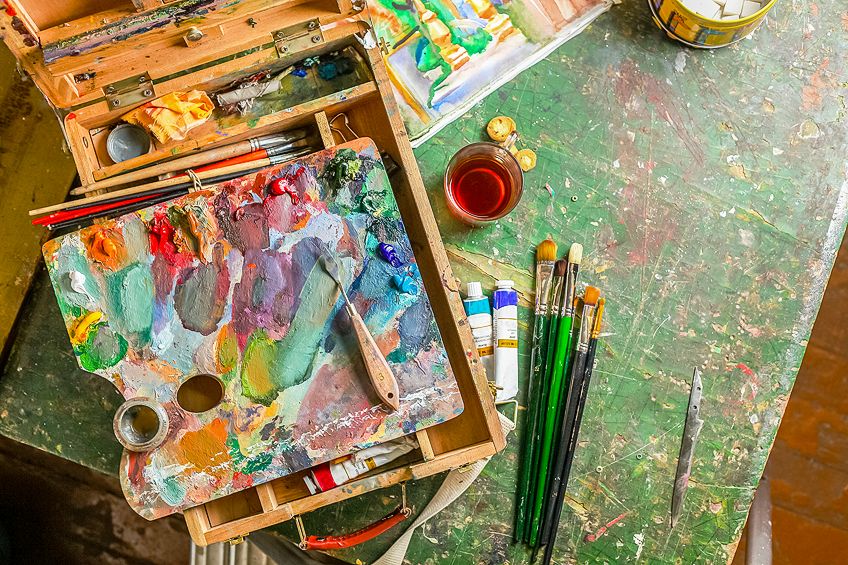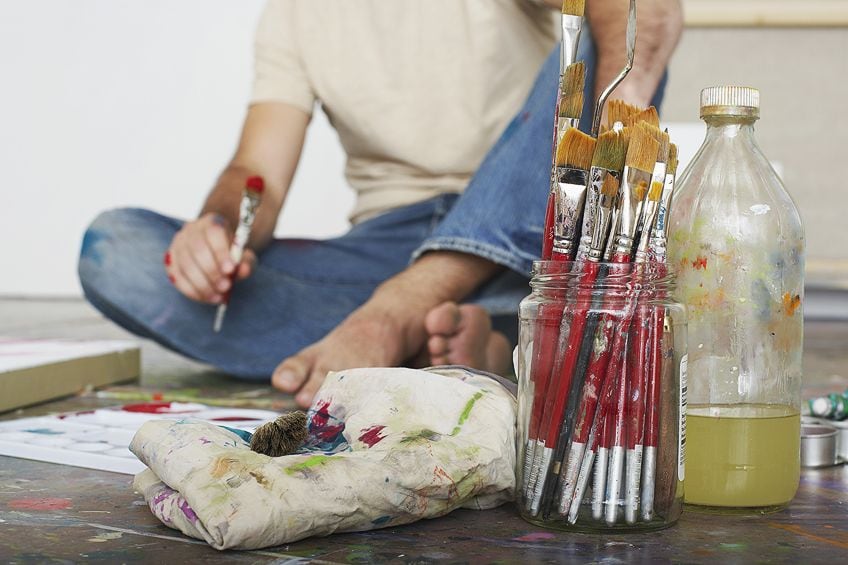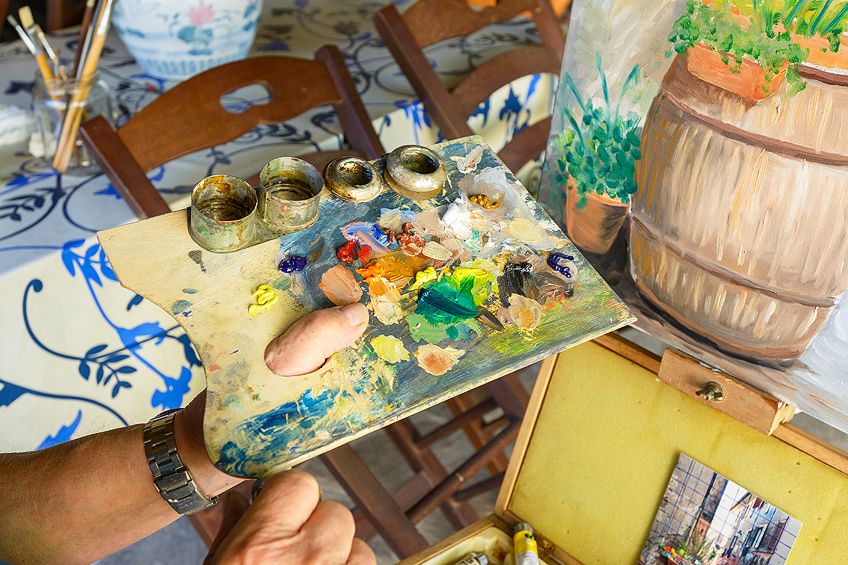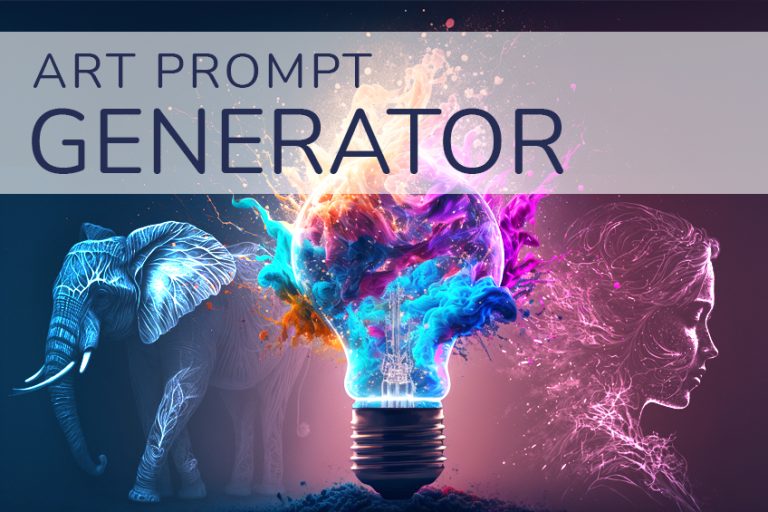Oil Painting Mediums – Choosing the Best Medium for Oil Painting
When it comes to painting with oil-based paint, there are so many oil mediums that can be added to the mixture. This is done to change the finish, consistency, drying time, and transparency of the paint. Additionally, it can also be used to stretch out the use of your paint by making it last longer. An oil medium can come in many different forms and, as a result, can and will produce different effects. This can make it tough to determine the best medium for oil painting from the get-go, but not to worry! When it comes to oil mediums, we have everything you need to make an informed decision.
Table of Contents
- 1 Why Use an Oil Paint Medium?
- 2 Using Different Types of Oil Painting Mediums
- 3 Have You Found Your Ideal Oil Paint Medium?
- 4 Frequently Asked Questions
- 4.1 What Is the Most Commonly Used Medium?
- 4.2 What Makes Oil Paint Better Than Acrylic Paint?
- 4.3 What Do I Need for Oil Painting?
- 4.4 Why Do I Need an Oil Medium?
- 4.5 What Is the Best Method of Incorporating a Medium?
- 4.6 What Is the Benefit of Using an Alkyd?
- 4.7 How Can You Seal Oil Paint?
- 4.8 What Is the Best Medium?
Why Use an Oil Paint Medium?
The most obvious question you may be seeking to answer is why do you even need to consider an oil paint medium? Well, an oil medium can alter the properties of the paint, making it more malleable and easier to manipulate. The oil paint that comes directly from the tube can be thick and difficult to work with. Different colors of the same brand may offer different viscosities in addition to drying times, and oil painting mediums can assist in giving the different colors the same qualities.

It is worth noting that most oil paints already have some sort of oil medium in them. In most cases, an oil binder is used to bind the pigment. That is all oil paint is – oil and pigment mixed. However, by introducing new mediums into the mix, you can take this already versatile art supply and make it your own.
Oil painting mediums recipes will create different outcomes, which is something that needs to be considered when it comes to finding the best medium for oil painting. Achievable effects including thinning or thickening the paint as well as influencing the drying time and texture. It can also change the finish from matte to gloss and even smooth out brush strokes.
By knowing which oil paint medium achieves which results, you can find the option best suited to your needs and create your own oil painting mediums recipes.
Using Different Types of Oil Painting Mediums
A painting medium allows artists to control oil-based paints more accurately by altering their characteristics. By knowing and understanding these oil mediums, different results can be achieved and take the piece of art to a whole new level. Using an oil paint medium requires some research and experimentation to achieve the specific result, but once you have the oil painting medium recipes sorted, the rest is smooth sailing.
Using a Solvent as an Oil Medium
When you use a solvent as an oil medium, you are able to give the oil-based paint a matte finish, increase the flow, thin out paint, increase transparency, and speed up the time it takes to dry. A solvent is usually used to clean painting gear and equipment like for cleaning oil painting brushes; however, many artists use it to facilitate their creativity and bring their imagination to life. When mixed with oil-based paint, the solvent then evaporates and leaves the binder and pigment to oxidize. This can then make the color appear brittle, dry, and dull.
It is recommended that you use a solvent only in the early stages of your painting, as this way it will not affect the end result.
Knowing how much to use will further assist as you work on your painting. Using too much of a solvent will result in a chalky effect that often cracks and distorts the art. When it comes to using a solvent for the first time, the general rule of thumb is to work on color blocking with pigment and solvent, working your way to a 1:2 oil-to-solvent ratio, and then gradually increasing the amount of oil with each additional layer.
To make your own oil medium, add linseed stand oil or cold-pressed linseed oil to your solvent of choice. The oil needs to be added to the solvent for this to work and not the solvent to the oil. Combine the mixture and let it sit for 48 hours to combine.

Turpentine
Turpentine, or turps, is the go-to choice for most artists as it is compatible with oil paint. When mixed, paint pigments will be perfectly dispersed and provide a beautiful, even finish. You need to buy artist-grade turpentine, however, as it contains fewer impurities. It is worth reminding you that turpentine is toxic when inhaled, so work in a well-ventilated space when using this oil medium.
Recommended Brand of Turpentine: DIAMOND G FOREST PRODUCTS Pure Gum Spirits of Turpentine
Slash pine trees are used in this turpentine, sourced using sustainable forest practices in south Georgia. The raw gum is fire distilled based on hundreds of years of tradition before being hand-packaged and labeled for shipment. This historical blend is ideal when it comes to thinning out the paint.
- Sustainably made from slash pine trees growing in south Georgia
- 100% pure turpentine made from fire-distilled raw gum
- Bottled, labeled, packaged, and shipped by hand
PROS
- 100% pure and free of impurities
- High-quality product
- Affordable price tag
CONS
- Toxic and not suitable for human consumption
Oil of Spike Lavender
Oil of spike lavender is a great alternative to turpentine as it mixes well with oil mediums and can break down and dissolve resins. This makes it the best product when it comes to thinning out thicker paints. What you may not know, however, is that this product is stronger than turpentine when it comes to solvents, which means that you can use less of it to thin out your paint. It can provide improved clarity, particle dispersion, as well as an adhesive for the different layers of paint. While this solvent is stronger than turpentine, it is less toxic, producing strong vapors with a more pleasant aroma.

Recommended Brand of Oil of Spike Lavender: CHELSEA CLASSICAL STUDIO Lavender Spike Oil
This product by Chelsea Classical Studio is natural and does not pose adverse health effects to artists using the solvent. The pleasant aroma makes it appealing to use and does not stink up your workspace. This oil medium can also be mixed with varnishes and resins, in addition to paints.
- A safer, natural alternative to Turpentine with a sweet lavender scent
- A natural solvent that thins oil painting mediums, resins, and varnishes
- Perfect for use with fine oil colors, blending colored pencils, and more
PROS
- Natural product
- Sweet-smelling odor
- Dissolves varnishes and resins
CONS
- Lavender smell is very strong
ro
Spirits
Odorless mineral spirits are another artist staple when it comes to thinning paint and are a great option if you are looking for a solvent that does not have a toxic odor – although it is still a toxic substance. Unlike turpentine, mineral spirits are not as compatible with oil paints due to the abrasive nature of the substance. This medium is also waterier and dries a lot slower than turpentine.
We recommend spirits as a brush cleaner and not as an oil medium as it can weaken the paint and provide a less desirable finish.
Recommended Brand of Spirits: WEBER Odorless Turpenoid
This Weber product is almost as powerful a turpentine without the strong odor. It has all of the solvent-like qualities associated with turpentine without smell, and can easily be used to clean brushes or thin out oil paints.
- The best odorless, volatile, and thin turpentine substitute
- Same painting properties and drying time as turpentine
- Odorless - does not have the strong odor like turpentine has
PROS
- Responds to paint the same way as turpentine
- Odorless
- Compatible with alkyd and oil
- Will not affect paint color
CONS
- Not as strong as turpentine
Using an Oil as an Oil Paint Medium
Now that we have taken a look at the solvent aspect of oil paint mediums, you are now ready to look at the next part, the oils. When you decide to add oil, you are more than likely looking to thicken paint, increase paint flow and transparency, and slow down the drying time. It is worth noting that not all oils can be used when painting with oil-based paint.

This because these oils are siccative and have gone through a process known as polymerization, which allows the oil to combine with air and create a solid layer. This oxidizing ability is why many people refer to these mediums as drying oils.
Tung, perilla, and soybean oils are also common mediums, although they are not as user-friendly as linseed, walnut, poppy seed, and safflower oil.
Linseed Oil
This oil comes from the ripe, dry flax plant. This means that it is sometimes sold as flaxseed oil or flax oil. This oil is incredibly durable, which is why it is often used to create oil mediums. It provides a glossy finish to paints, slows down the time they take to dry, and reduces the paint’s viscosity. Another favorable quality of this oil is its linoleic and linolenic acid, which help to produce a durable, long-lasting paint film, although they can result in yellowing of the paint with age. When it comes to selecting an oil, look for an oil with linolenic acid, as it builds a strong film.
Recommended Brand of Linseed Oil: WINSOR & NEWTON Linseed Oil
When it comes to oil mediums, Winsor and Newton have a product range that meets all needs. This prodyct has all of the properties you look for in linseed oil and produces the long-lasting, glossy finish that artists seek to achieve when using this oil medium.
- Refined linseed oil is the most commonly used oil by artists
- Add to oil paints to slow the drying time or to reduce consistency
- Increases the gloss and transparency of oil paints
PROS
- Slows drying time of paint
- Reduces oil consistency
- Adds gloss
- Improves transparency
CONS
- The cap of the bottle can be tricky to open
Cold-Pressed Linseed Oil
Cold-pressed linseed oil can be used with oil of spike lavender to create a lean medium if that is what you are looking to achieve. This variety of linseed oil creates a harder, shinier finish, and also takes less time to dry. This high-quality oil is used as a binder in many oil paints and is often mixed with professional paints made using rich, pure pigments. The acid content makes it a great choice for a binder and coats pigments a lot more effectively than other oils.

Recommended Brand of Cold-Pressed Linseed Oil: Winsor & & Newton Cold-Pressed Linseed Oil
Winsor & Newton Cold Pressed Linseed Oil is a trusted companion for oil painters seeking to elevate their artwork. Specially formulated to enhance the flow and transparency of oil paints, it empowers artists to achieve smooth brushwork and vivid colors with ease.
- Enhances oil paint flow and transparency
- Accelerates drying time
- Increases gloss and depth
PROS
- Enhances paint flow and transparency
- Accelerates drying time
- Adds gloss and depth to artworks
CONS
- May cause yellowing over time
- Can increase the risk of cracking if applied too thickly
Linseed Stand Oil
Linseed stand oil, or linseed bodied oil, is also derived from the flax plant. It is different in that it is made from refined linseed oil that has been heated to high temperatures in a vacuum-sealed chamber. It is more concentrated as a result and has a thicker consistency, which stretches out your paint and allows you to do more with a lot less. It is also ideal for glazing and will leave a glossy finish.
Another great benefit that comes with this oil is that does not yellow with age like other linseed oils, and it is also not as easily absorbed into the layer, which makes the paint appear dull.
Recommended Brand of Linseed Stand Oil: WINSOR & NEWTON
Winsor and Newton are big names when it comes to painting. Their linseed stand oil provides a durable, smooth finish while slowing down the drying time of your oil paints. It also reduces the risk of brush marks and helps make the paint and color last longer.
- A pale viscous oil that slows the drying time of oil paints
- Increases film durability and leaves a smooth, tough enamel finish
- Ideal for glazing and fine details when mixed with a solvent
PROS
- Smooth finish
- Tough, durable film
- Reduced brush marks
- Suitable for glazing
CONS
- Lid is difficult to open
Safflower Oil
Safflower oil only contains linoleic acid and, as a result, is seen as a weaker binder. As an oil medium, this oil reduces viscosity while increasing flow. Paint is, therefore, more easily spread. Safflower oil also produces a film that does not wrinkle with age; however, it is weaker than other oils. It is also slow drying to the point that it never completely dries or cures. When exposed to excessively hot temperatures, the paint has been known to melt.

Safflower oil is not often recommended as an oil paint medium, although, when used sparingly, it can provide great results. One such example is applying thin layers to your painting with the intention of mixing it with lighter colors. As with most mediums, there are ways to even out the unwanted and negative properties. For example, to counteract the weaker film layer, you can always apply a varnish to seal the paint layer.
Recommended Brand of Safflower Oil: MONT MARTE Safflower Oil
Mont Marte’s safflower oil is suitable for all colors, including white and pale hues, as the oil does not cause the paint to yellow. It can add gloss to your painting while slowing down the drying time, resulting in more time to fine-tune your masterpiece.
- Increases the flow and transparency of oil paints
- Medium-viscosity oil improves gloss and slows down drying time
- Resists yellowing, making it great for pale hues and white colors
PROS
- Improved flow
- Increased gloss
- Slower drying time
- Yellow-resistant
CONS
- Environmental changes can affect the paint structure
Poppy Oil
Poppyseed oil is a clear oil that will not yellow with age or affect the color of your painting in the long term. Monet used this oil as a binder when painting his Water Lilies series, which explains why his artworks have been able to maintain their bold, vibrant colors. This drying oil is one of the slowest to dry while improving the flow and gloss finish of your work. It also lacks linolenic acid, which makes the paint and its film softer. You can rectify this by adding linseed oil to the mix.
Recommended Brand of Poppy Seed Oil: WINSOR & NEWTON Poppy Oil
As you may have noticed, Winsor and Newton lead the pack when it comes to their product range of oil painting mediums. Their drying poppy oil dries quickly and will not yellow over time, making it perfect for use with light colors.
PROS
- Quick-drying
- Does not turn yellow
- Improved gloss
- Ideal for light hues
CONS
- Weak film
Walnut Oil
Another great alternative to linseed is walnut oil. It is more durable and flexible than safflower and poppyseed oil and will not yellow like linseed oil. This oil can be mixed into paint the same way you would other oils and can even be used to clean brushes if you are looking to keep your workspace free from solvents. Walnut oils are incredibly glossy, add depth of color, and are hard-wearing. They are also able to slow down the drying time and improve paint flow.

We recommend storing this oil in the fridge as warm temperatures and exposure to sunlight can cause the oil to go rancid. While you should be aware of the fact that all oils will go rancid as a result of air exposure, nut-based oils will go rancid if the bottle is not properly stored or sealed. This oil can also be used in oiling out a painting, which is when you apply a thin layer of oil to a dry area of the painting to restore the color and its vibrancy.
Recommended Brand of Walnut Oil: M GRAHAM Walnut Oil
This walnut oil offers greater artistic freedom while reducing the appearance of streaks and brush strokes. It will also resist yellowing, resulting in colors that stay vibrant. The slow-drying nature of this medium also allows artists more time to perfect their work of art.
- Removes color from brushes without creating a solvent hazard
- Addition of walnut oil to color will increase flow and slow drying
- Retains brilliance of color due to non-yellowing properties
PROS
- Easily cleans brushes
- Increases paint flow
- Takes longer to dry
- Non-toxic
CONS
- Greasy residue
Using a Cold Wax as an Oil Paint Medium
If you are looking to thicken your paint to add volume, body, texture and provide a matte finish with a speedy drying time, then we recommend using cold wax. The thick texture of this oil medium is unique and even has a style of painting dedicated to its use. Cold wax painting is a style that involves textures, magnificent brush strokes, and beautiful matte finishes. If you do not want a matte finish but want the textured benefits, try adding alkyd to the mix.
Cold wax adds a whole new dimension to paintings and allows you to build layers to add structure. It can also add increased transparency and luminosity to your work.
There are so many ways to add cold wax to oil paints in order to create a wide range of effects. In most cases, the medium is a mix of solvents, resin, beeswax, and even linseed oil. This is because the solvent evaporates while the wax hardens to create a lasting impression.
Recommended Brand of Cold Wax: GAMBLIN Cold Wax Medium
Gamblin’s cold wax medium not only thickens your paint but provides a beautiful matte finish to your painting. In a pinch, you can thin it out using an odorless solvent. You can also add alkyd to the mix to further enhance the paint’s flexibility as well as sheen. This product can be used as a varnish and is incredibly versatile.
- Used to make oil colors thicker and more matte
- Can be thinned to brush consistency by dissolving it in OMS
- Add galkyd to cold wax medium to increase sheen and flexibility
PROS
- Thickens paints
- Increases flexibility
- Takes longer to dry
- More artistic freedom
CONS
- Delayed drying puts structure and texture at risk
Using an Alkyd Resin as an Oil Paint Medium
To add body to your painting while speeding up the drying time and adding a glossy finish, we recommend an alkyd resin. This is a synthetic resin that consists of a polymerized plant-based oil and a slow-evaporating, odorless solvent. When mixed with oil, it should dry within a day. This is the ideal medium for the fast painter that does not want to wait weeks between layers. Alkyds can also help stretch your paint without becoming too transparent or runny.

Recommended Brand of Alkyd Resin: WILLIAMSBURG Alkyd Resin Oil
Williamsburg’s alkyd resin oil is made from pure alkyd resin and contains a small amount of odorless paint thinner. It is quick-drying and will not yellow over time, which is a major benefit when it comes to using a medium in your oil paints.
- Premium quality alkyd resin oil for professional artists and hobbyists alike
- Offers exceptional durability, vibrant color retention, and smooth application
- Ideal for creating vivid and long-lasting oil paintings with a classic finish
PROS
- High-quality alkyd resin oil
- Provides vibrant color retention
- Smooth application
CONS
- Longer drying time
- Requires proper ventilation
- Pricey
Have You Found Your Ideal Oil Paint Medium?
Part of the process of finding your ideal oil painting medium is experimenting and playing with the different mediums available. Not only will this help you work on your craft, but it will also make it all the more exciting to do. Oil paint mediums can elevate your artistic creation to new heights by making the color and texture stand out while giving you the freedom to continuously work and change your design.
Taking the time to understand the different oil mediums and techniques will go a long way on your journey to artistic freedom and self-expression. At the end of the day, it is about finding the medium that best helps you express yourself and strut your style.
Our parting words of wisdom are to follow your passion and to experiment with styles and techniques while making your artwork your own. Do not let the naysayers influence you, the beauty of oil paint is the freedom it provides, and by choosing an oil paint medium to assist you, you will truly be able to harness the benefits of the oil painting experience.
Frequently Asked Questions
What Is the Most Commonly Used Medium?
Without a doubt, linseed oil is the artist’s standard. This traditional oil paint medium increases the drying time while thinning out the paint. This is beneficial for artists looking to spend more time on their creations while having the freedom to make changes.
What Makes Oil Paint Better Than Acrylic Paint?
One of the greatest benefits offered by oil paints is their delayed drying time. Unlike acrylics, it takes longer for the oil paint to dry, which means that artists have more time to work on their colors and textures. This also means that you do not need to worry about the paint on your palette drying out before you have time to use it all. You use less paint in the process, waste less paint, and save money all in one go. Of course, this depends on your needs and what you are working on. If you would prefer paint that dries faster, then acrylic should be on your list. It is worth noting that you can use acrylic paints for the basis of your painting before adding layers of oil paint.
We have a separate blog post about oil vs acrylic paints.
What Do I Need for Oil Painting?
When it comes to painting with oil, there are a few things that should be in your setup. The first and most obvious being the surface or canvas, paint, and paintbrushes. Next, you will want to buy some oil paint mediums to assist you along the way. In addition to this, we recommend a jar for cleaning your brushes, rags for cleaning up, a palette for your paint, pencils for drawing, and clothes that you do not mind ruining in the process.
Why Do I Need an Oil Medium?
Some may argue that paint is in its best possible form and condition when it comes directly from the tube. Most high-quality paint manufacturers have not created their products to be influenced by mediums, so when you are using these more expensive, premium brands, a medium will more than likely not be necessary. However, lower-grade paints may require assistance in giving the result that you are looking for. Of course, at the end of the day, it is about what you want to achieve with your art and finding the best way to do so.
What Is the Best Method of Incorporating a Medium?
Most art teachers will teach their students to paint first and then add a medium to the mix to thin it out or smooth the appearance if necessary. When it comes to oil mediums, you need to be sure of your intent and be cautious when adding them to your paint. Rather add bit by bit until you get the desired results. Remember, oil paints are supposed to be stable while providing the freedom to alter them at any given time. The general rule of thumb is not to exceed 50 percent oil capacity when it comes to your paint mixture.
What Is the Benefit of Using an Alkyd?
An alkyd allows the paint to dry a lot faster due to the fact that it contains a solvent, which in most cases, is turpentine. As the solvent evaporates, the paint will begin to dry. Depending on the paint thickness, it should be able to dry overnight. This means that you can work for a few days in a row instead of waiting weeks between applications.
How Can You Seal Oil Paint?
In addition to being fast-drying, an alkyd can also be used to seal paint by creating an isolating layer. Once you have finished your work, you can apply a layer of alkyd to it. This glaze can be added to your art without the risk of lifting the paint. For the best results, the paint needs to dry completely and then have the alkyd applied. Once dried, you can paint over with a glaze or opaque paints. You can reseal it at any time to lock in the layers.
What Is the Best Medium?
This is a difficult one. The reason there are so many mediums available is that they offer different results and are used for different purposes. In addition to this, you can create your own oil medium recipe to ensure that you achieve the result you are looking for. This all requires time, patience, and creativity to figure out. The first thing to do in it all, however, is to decide what it is you want to achieve. This will guide the way in terms of what medium to try and how to further enhance your paint.
In 2005, Charlene completed her Wellness Diplomas in Therapeutic Aromatherapy and Reflexology from the International School of Reflexology and Meridian Therapy. She worked for a company offering corporate wellness programs for a couple of years, before opening up her own therapy practice. It was in 2015 that a friend, who was a digital marketer, asked her to join her company as a content creator, and this is where she found her excitement for writing.
Since joining the content writing world, she has gained a lot of experience over the years writing on a diverse selection of topics, from beauty, health, wellness, travel, and more. Due to various circumstances, she had to close her therapy practice and is now a full-time freelance writer. Being a creative person, she could not pass up the opportunity to contribute to the Art in Context team, where is was in her element, writing about a variety of art and craft topics. Contributing articles for over three years now, her knowledge in this area has grown, and she has gotten to explore her creativity and improve her research and writing skills.
Charlene Lewis has been working for artincontext.org since the relaunch in 2020. She is an experienced writer and mainly focuses on the topics of color theory, painting and drawing.
Learn more about Charlene Lewis and the Art in Context Team.




















